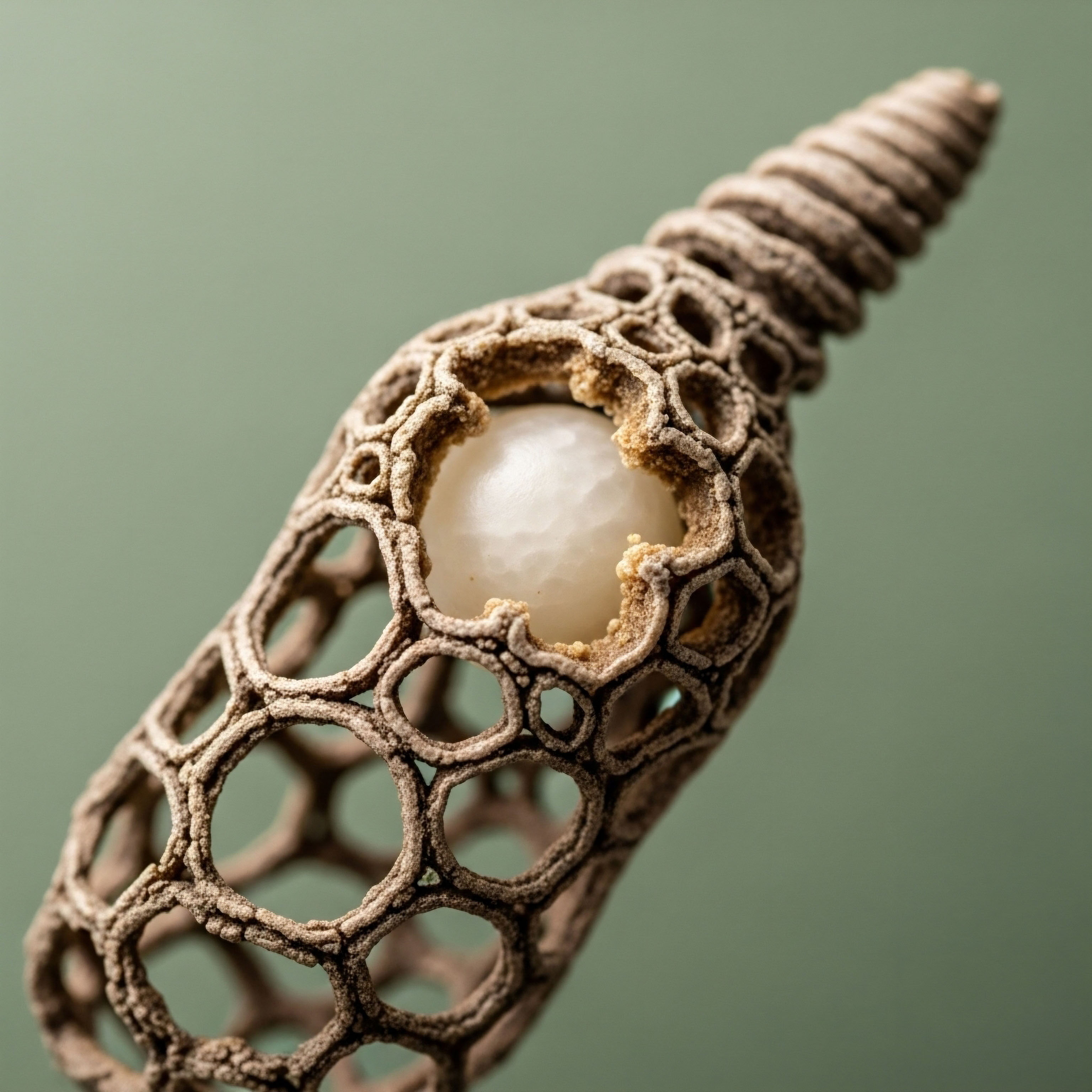

Fundamentals
Feeling a change in your body’s integrity, a subtle loss of resilience, is a deeply personal experience. It often begins quietly, a sense of fragility that is difficult to articulate but profoundly felt. This sensation is frequently rooted in the silent, intricate dance of hormones within your skeletal system.
Your bones are not static, inert structures; they are dynamic, living tissues in a constant state of renewal, a process meticulously orchestrated by your endocrine system. Understanding this biological conversation is the first step toward reclaiming a sense of structural strength and vitality.
The architecture of your skeleton is maintained through a process called remodeling, which involves two primary types of cells ∞ osteoblasts, the builders that construct new bone tissue, and osteoclasts, the demolition crew that removes old or damaged bone. For your bones to remain strong and dense, the activity of these two cell types must be in equilibrium.
Hormones are the master regulators of this delicate balance, sending powerful signals that can either ramp up bone formation or accelerate its breakdown. When hormonal shifts occur, particularly the decline in sex hormones like estrogen and testosterone that accompanies aging, this carefully calibrated system can be thrown into disarray.
The continuous renewal of your skeleton is a hormonally-guided process, where a delicate balance between bone-building and bone-clearing cells dictates your structural health.
Estrogen, for instance, is a powerful guardian of bone density. It functions by restraining the activity of osteoclasts, the cells responsible for bone resorption. Think of estrogen as a calming influence, ensuring that the demolition crew does not become overzealous and tear down more bone than the builders can replace.
When estrogen levels decline, as they do precipitously during menopause, this restraining signal weakens. The osteoclasts become more numerous and more active, leading to a net loss of bone mass. This is the underlying mechanism that contributes to the heightened risk of osteoporosis in postmenopausal women. The process is silent and gradual, yet it fundamentally alters the internal scaffolding of your bones, making them more porous and susceptible to fracture.

The Protective Roles of Key Hormones
While estrogen’s role is widely discussed, testosterone also plays an indispensable part in skeletal maintenance, for both men and women. Testosterone contributes to bone health through a dual-action mechanism. It directly stimulates osteoblasts, the bone-building cells, encouraging them to fortify the skeleton.
Concurrently, a portion of testosterone is converted into estrogen within bone tissue itself, and this localized estrogen then helps to suppress the bone-resorbing activity of osteoclasts. Therefore, a decline in testosterone, a hallmark of andropause in men, removes a critical stimulus for bone formation while also diminishing this protective, anti-resorptive effect. This creates a scenario where bone is being built more slowly and broken down more quickly, leading to a gradual erosion of bone strength.
Growth hormone (GH) and its primary mediator, insulin-like growth factor-1 (IGF-1), are also central to this narrative. Throughout life, GH and IGF-1 are powerful anabolic signals, promoting the growth and mineralization of bone. They are essential for achieving peak bone mass during adolescence and continue to support the remodeling process in adulthood.
A reduction in GH secretion, a natural part of the aging process, means there is less stimulation for bone-building osteoblasts. This contributes to the age-related decline in the skeleton’s ability to repair and reinforce itself, further compounding the effects of declining sex hormones.


Intermediate
To truly grasp how hormonal shifts compromise skeletal integrity, we must move beyond general concepts and examine the specific molecular conversations occurring within bone tissue. The process is governed by a sophisticated signaling network, and understanding its components reveals precisely where and how hormonal decline exerts its effects. This deeper knowledge illuminates the rationale behind targeted clinical interventions designed to restore skeletal balance.
At the heart of estrogen-mediated bone protection is a critical signaling trio known as the RANK/RANKL/OPG pathway. Think of this as a molecular switch that controls the birth and activation of osteoclasts, the cells that dissolve bone mineral.
RANKL is a protein produced by osteoblasts that acts as the “on” signal; when it binds to its receptor, RANK, on the surface of osteoclast precursor cells, it triggers their maturation and unleashes their bone-resorbing capacity. To prevent this process from running unchecked, the body produces a decoy receptor called osteoprotegerin (OPG).
OPG works by binding to RANKL, effectively intercepting the “on” signal before it can reach the osteoclast precursors. A healthy balance between RANKL and OPG is therefore essential for maintaining skeletal homeostasis.
Hormonal control over bone density is largely managed by the RANKL/OPG signaling ratio, which functions as a master regulator of the cells that break down bone tissue.
Estrogen’s primary role in this system is to maintain a favorable balance. It does this by stimulating the production of OPG, the protective decoy receptor, and simultaneously suppressing the expression of RANKL, the activation signal. When estrogen levels fall during perimenopause and menopause, this dual influence is lost.
RANKL expression increases while OPG production decreases, tipping the ratio heavily in favor of osteoclast activation. This molecular imbalance is the direct cause of the accelerated bone resorption that characterizes the menopausal transition, providing a clear target for therapeutic intervention.

How Do Specific Hormonal Therapies Counteract Bone Loss?
Understanding these mechanisms allows us to appreciate the precision of modern hormonal optimization protocols. These are not blunt instruments but targeted strategies designed to recalibrate the specific pathways disrupted by hormonal decline.

Targeted Hormone Replacement for Women
For postmenopausal women, hormonal therapy directly addresses the root cause of bone loss. By reintroducing estrogen, these protocols restore the systemic signals that suppress RANKL and promote OPG, thereby re-establishing control over osteoclast activity. The addition of progesterone is often included to protect the uterine lining, but it also has its own modest, positive effects on bone formation.
For women experiencing symptoms of androgen insufficiency, a low dose of testosterone can be introduced. This supports bone health by directly stimulating osteoblasts and providing a substrate for local estrogen conversion within the bone itself, offering a two-pronged approach to skeletal support.

Androgen Support and Its Impact on Male Bone Structure
In men experiencing age-related testosterone decline, Testosterone Replacement Therapy (TRT) is a cornerstone of preserving bone density. The standard protocol involving weekly injections of Testosterone Cypionate works to directly restore the anabolic signals that drive osteoblast activity. Its effects are amplified by its conversion to estradiol in bone tissue, which helps to inhibit bone resorption. To ensure a balanced endocrine response, adjunctive therapies are often used:
- Gonadorelin ∞ This agent is used to maintain testicular function and endogenous testosterone production, preventing the complete shutdown of the natural hormonal axis.
- Anastrozole ∞ As an aromatase inhibitor, this oral medication modulates the conversion of testosterone to estrogen. This helps manage potential side effects related to excess estrogen while ensuring enough is present to exert its protective effects on bone.
This multi-faceted approach ensures that the hormonal environment is optimized not just for symptom relief, but for the long-term preservation of skeletal architecture.

The Role of Growth Hormone Peptides
For individuals seeking to enhance tissue repair and optimize metabolic function, Growth Hormone Peptide Therapy offers another layer of support for skeletal health. Peptides like Sermorelin and Ipamorelin/CJC-1295 work by stimulating the body’s own production of GH.
This, in turn, increases circulating levels of IGF-1, a potent stimulator of osteoblast function and collagen synthesis, which forms the protein matrix of bone. This approach promotes a more robust bone-building environment, complementing the actions of sex hormones and providing a powerful anabolic stimulus for maintaining a strong and resilient skeleton.
The following table outlines the primary mechanisms through which key hormones influence the cells responsible for bone remodeling.
| Hormone | Effect on Osteoblasts (Bone Builders) | Effect on Osteoclasts (Bone Resorbers) |
|---|---|---|
| Estrogen |
Supports survival and function. |
Strongly inhibits activation and survival via the RANKL/OPG pathway. |
| Testosterone |
Directly stimulates proliferation and differentiation. |
Indirectly inhibits by converting to estrogen within bone tissue. |
| Growth Hormone (via IGF-1) |
Potently stimulates proliferation and collagen synthesis. |
Minimal direct effect; primary influence is anabolic. |


Academic
A sophisticated analysis of hormonal influence on skeletal dynamics requires an appreciation of the interconnectedness of endocrine axes and local, or paracrine, signaling within the bone microenvironment. The systemic decline of gonadal and pituitary hormones with age establishes a permissive environment for bone loss.
The ultimate fate of bone tissue is determined by the complex interplay between these systemic signals and the local cellular responses they govern. The primary driver of age-related bone fragility, particularly in women, is the dysregulation of the RANKL/OPG signaling axis secondary to estrogen deficiency.
Estrogen’s regulatory authority over this system is exerted through its binding to estrogen receptor-alpha (ERα), which is expressed in cells of the osteoblast lineage. This interaction initiates a cascade of transcriptional events that have a dual, beneficial outcome for bone preservation.
Firstly, it directly suppresses the transcription of the gene encoding RANKL (TNFSF11), thereby reducing the availability of the key cytokine required for osteoclastogenesis. Secondly, it upregulates the transcription of the gene for OPG (TNFRSF11B), increasing the concentration of the soluble decoy receptor that neutralizes RANKL. The menopausal decline in circulating estradiol effectively removes this transcriptional brake on RANKL and the accelerator on OPG, leading to a profound shift in the RANKL/OPG ratio that favors bone resorption.
The molecular basis of postmenopausal osteoporosis lies in the loss of estrogen-receptor-mediated transcriptional control over the RANKL/OPG system within bone cells.

What Is the Cellular Source of Pathological RANKL Expression?
While multiple cell types can produce RANKL, research has pinpointed bone lining cells and osteocytes as critical sources of the RANKL that drives pathological bone loss in states of estrogen deficiency. Osteocytes, embedded within the bone matrix, are exquisitely sensitive to mechanical and hormonal signals.
In an estrogen-replete environment, their expression of RANKL is kept in check. Following estrogen withdrawal, these cells significantly increase their RANKL production, transmitting resorptive signals to the bone surface and initiating the remodeling process from deep within the matrix. This highlights the osteocyte as a master regulator of bone turnover, translating systemic hormonal changes into local remodeling events.

The Contribution of the Immune System
The endocrine and immune systems are deeply intertwined, and this connection is highly relevant to bone health. Activated T-lymphocytes are another potent source of RANKL. Estrogen has immunomodulatory effects, and its decline can lead to an increase in pro-inflammatory cytokines such as TNF-alpha and Interleukin-6.
These cytokines can, in turn, stimulate T-cells to produce more RANKL, further exacerbating the resorptive environment. This creates a feed-forward loop where hormonal decline promotes a low-grade inflammatory state that actively contributes to skeletal degradation.

Androgens and the Somatotropic Axis a Mechanistic View
The role of androgens in male skeletal health is multifaceted, involving both direct receptor-mediated actions and indirect effects via aromatization to estrogen. Testosterone, acting through the androgen receptor (AR) on osteoblasts, promotes their proliferation and differentiation, directly contributing to the periosteal expansion that creates larger, stronger bones in men.
However, the importance of its aromatization to estradiol cannot be overstated. Men with inactivating mutations in the aromatase enzyme or the estrogen receptor exhibit severe osteoporosis, demonstrating that estrogen is indispensable for inhibiting bone resorption in men as well as women.
The somatotropic axis, comprising GH and IGF-1, is a critical anabolic force for the skeleton. Systemic IGF-1, primarily produced by the liver under GH stimulation, and locally produced IGF-1 within bone work in concert to promote osteoblast function.
IGF-1 enhances the synthesis of type I collagen, the primary protein component of the bone matrix, and stimulates the differentiation of osteoprogenitor cells into mature osteoblasts. The age-related decline in GH secretion, known as somatopause, reduces this vital anabolic support, impairing the bone’s capacity for formation and repair and rendering it more vulnerable to the net resorptive state driven by concurrent sex steroid deficiency.
The following table details the key molecular mediators and their primary function in the context of hormonal control of bone remodeling.
| Mediator | Molecular Class | Primary Function in Bone Remodeling |
|---|---|---|
|
RANKL |
Transmembrane Protein (TNF Superfamily) |
Essential cytokine for osteoclast differentiation, activation, and survival. |
|
OPG |
Soluble Receptor (TNF Receptor Superfamily) |
Decoy receptor that binds to RANKL, preventing its interaction with RANK and inhibiting bone resorption. |
|
Estrogen Receptor-Alpha (ERα) |
Nuclear Hormone Receptor |
Mediates estrogen’s primary effects on bone, suppressing RANKL and stimulating OPG transcription. |
|
Androgen Receptor (AR) |
Nuclear Hormone Receptor |
Mediates testosterone’s direct anabolic effects on osteoblasts, promoting bone formation. |
|
IGF-1 |
Peptide Hormone |
Stimulates osteoblast proliferation, differentiation, and collagen synthesis, driving bone formation. |
In summary, the structural integrity of the skeleton over a lifetime is a direct reflection of the dynamic equilibrium between anabolic and catabolic signaling pathways, which are themselves governed by the endocrine system.
The decline in estrogen, testosterone, and growth hormone creates a multi-pronged assault on bone mass ∞ the restraint on resorption is lifted, the stimulus for formation is diminished, and the background inflammatory state is heightened. Clinical protocols that aim to restore hormonal balance are therefore addressing the fundamental biochemical drivers of age-related skeletal fragility.

References
- Eastell, R. et al. “Pharmacological Management of Osteoporosis in Postmenopausal Women ∞ An Endocrine Society Clinical Practice Guideline.” The Journal of Clinical Endocrinology & Metabolism, vol. 104, no. 5, 2019, pp. 1595-1622.
- Khosla, S. et al. “Estrogen Regulates Bone Turnover by Targeting RANKL Expression in Bone Lining Cells.” Nature Medicine, vol. 23, no. 7, 2017, pp. 846-855.
- Mohan, S. and C. A. Baylink. “The role of insulin-like growth factor-1 in bone remodeling ∞ A review.” International Journal of Biological Macromolecules, vol. 238, 2023, p. 124125.
- Vanderschueren, D. et al. “Testosterone and the Male Skeleton ∞ A Dual Mode of Action.” Journal of Osteoporosis, vol. 2012, 2012, p. 849408.
- Locatelli, V. and V. E. Bianchi. “Effect of GH/IGF-1 on Bone Metabolism and Osteoporsosis.” International Journal of Endocrinology, vol. 2014, 2014, p. 235060.
- Jiang, Y. et al. “Osteoporosis Due to Hormone Imbalance ∞ An Overview of the Effects of Estrogen Deficiency and Glucocorticoid Overuse on Bone Turnover.” International Journal of Molecular Sciences, vol. 23, no. 3, 2022, p. 1495.
- Adler, R. A. et al. “Osteoporosis in Men ∞ An Endocrine Society Clinical Practice Guideline.” The Journal of Clinical Endocrinology & Metabolism, vol. 97, no. 6, 2012, pp. 1802-1822.
- Sinnesael, M. et al. “Testosterone and Male Bone Health ∞ A Puzzle of Interactions.” The Journal of Clinical Endocrinology & Metabolism, vol. 106, no. 3, 2021, pp. e1041-e1056.

Reflection

Charting Your Path to Structural Resilience
The information presented here provides a map of the biological territory, detailing the intricate pathways through which your hormones sculpt your skeletal system. This knowledge is a powerful tool, transforming abstract feelings of vulnerability into a clear understanding of the underlying mechanisms at play.
Your personal health narrative is unique, written in the language of your own biochemistry and lived experiences. Recognizing how systemic changes connect to tangible sensations is the foundational step in moving from a passive observer to an active participant in your own wellness.
This journey into your body’s inner workings is deeply personal. The science offers the ‘what’ and the ‘how,’ but you provide the ‘why’ ∞ the motivation to seek balance, to restore function, and to build a future of vitality and strength. Consider this exploration not as a conclusion, but as an informed starting point.
The path forward involves translating this understanding into a personalized strategy, a protocol built not just on clinical data, but on your individual goals and biological truths. The potential to proactively manage your structural health is within your grasp, guided by a clear comprehension of the systems that define it.

Glossary

osteoblasts

osteoclasts

bone formation

bone resorption

bone density

osteoporosis

bone health

estrogen within bone tissue

growth hormone

igf-1

within bone tissue

rankl/opg pathway

skeletal homeostasis

bone loss

testosterone replacement therapy

gonadorelin

anastrozole

growth hormone peptide therapy

bone remodeling

estrogen deficiency

androgen receptor




